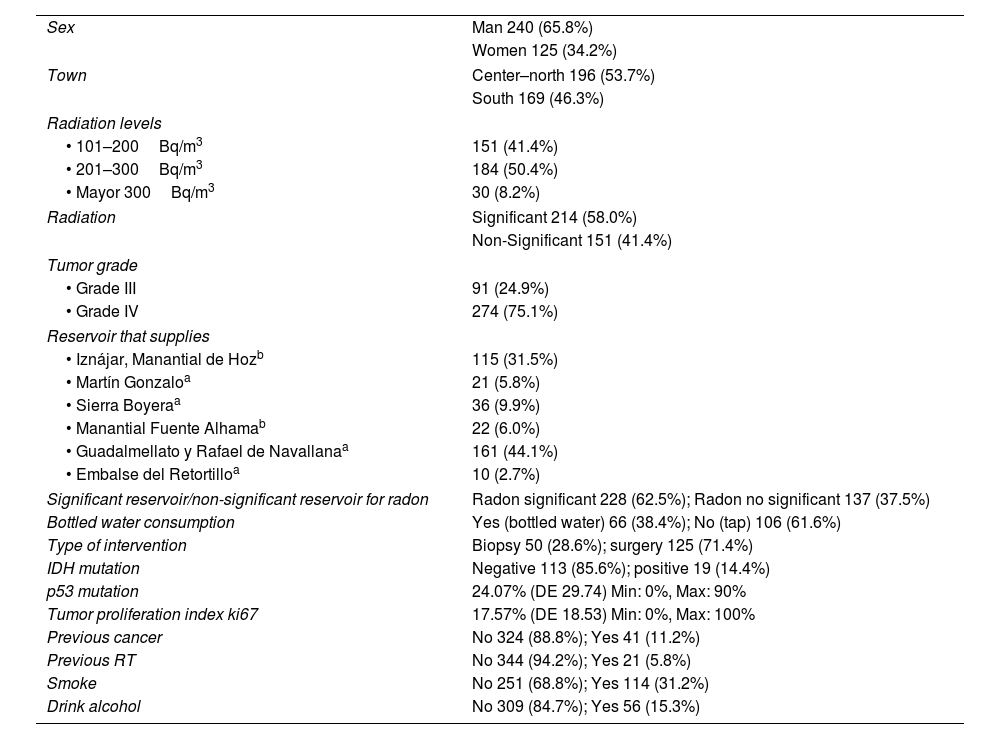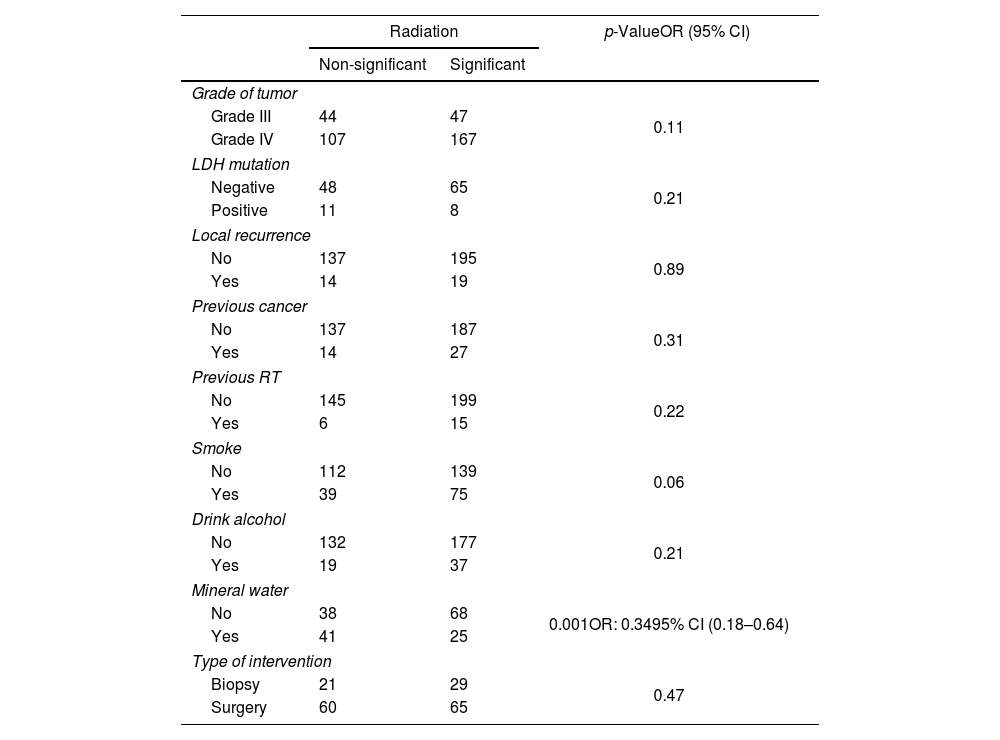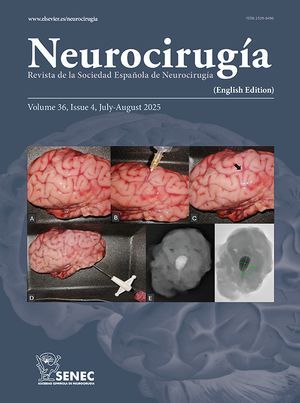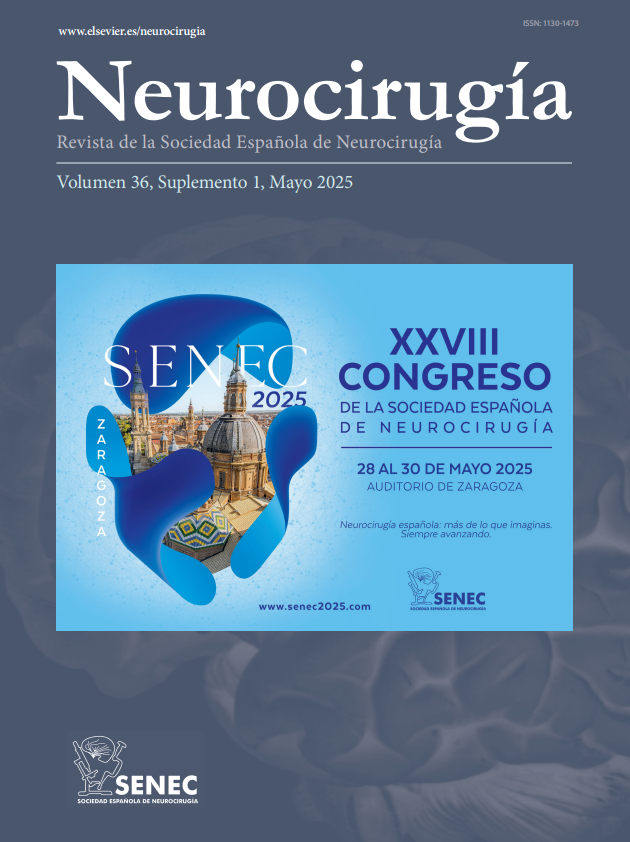To determine the relationship between the impact of high-grade gliomas (HGG) on the population in Córdoba from 2008 to 2019 and the natural radiation background, estimated using radon maps and water origin according to the supply reservoir. Correlation of the results with other prognostic factors. The survival study based on exposure to radon.
Material and methodsObservational, cross-sectional, retrospective 11-year study on 365 patients diagnosed with HGG at the Reina Sofía Hospital in Córdoba, exposed or not, to significant radiation, to estimate the impact that this could have on HGG.
ResultsThe incidence of patients diagnosed with glioblastoma multiforme (GBM) in those exposed to radon was 41.6 versus 31.4 cases/100,000 inhabitants in those not exposed (p=0.02). The global incidence of HGG was 52.8 cases in those exposed to radon compared with 45 cases/1000 inhabitants in the unexposed ones (p=0.12). It was found that 56.8/100,000 were supplied by reservoirs significant for radon, compared to 31.4 cases/100,000 inhabitants that were not (p=0.23). A Cox regression was performed, leaving IDH mutation and type of intervention in the model: survival is six times higher in positive IDH mutation (p=0.021) and three in surgically intervened (p<0.001).
ConclusionsLong-term exposure to natural radiation does seem to increase the risk factor for the appearance of GBM. However, other factors influencing such exposure must be considered, such as reliable measurements of radiation and time spent in that place.
Determinar la relación entre el impacto de los gliomas de alto grado (GAG) en la población de Córdoba entre 2008 y 2019 y la radiación natural de fondo estimada, utilizando mapas de radón y el origen del agua según el embalse de abastecimiento. Correlacionar los resultados con otros factores pronósticos. Estudio de supervivencia basado en la exposición al radón.
Material y métodosEstudio observacional, transversal y retrospectivo de 11 años de duración sobre 365 pacientes diagnosticados de GEI en el Hospital Reina Sofía de Córdoba, expuestos o no a radiación significativa, para estimar el impacto que ésta pudiera tener sobre los gliomas de alto grado.
ResultadosLa incidencia de pacientes con diagnóstico de glioblastoma multiforme (GBM) en aquellos expuestos a radón fue de 41,6 en comparación con 31,4 casos/100.000 habitantes en los no expuestos (p=0,02). La incidencia global de gliomas de alto grado fue de 52,8 casos en los expuestos a radón en comparación con 45 casos/1.000 habitantes en los no expuestos (p=0,12). Se encontró que 56,8/100.000 fueron abastecidos por reservorios significativos para radón, en comparación con 31,4 casos/100.000 habitantes que no lo fueron (p=0,23). Se realizó una regresión de Cox, dejando la mutación IDH y el tipo de intervención en el modelo: la supervivencia es 6 veces mayor en la mutación IDH positiva (p=0,021) y 3 veces en los que se sometieron a cirugía (p<0,001).
ConclusionesLa exposición prolongada a niveles de radiación natural parece aumentar el riesgo de GBM. Sin embargo, deben considerarse otros factores que influyen en dicha exposición, como mediciones fiables de la radiación y el tiempo de permanencia en dicho lugar.
Article

If it is the first time you have accessed you can obtain your credentials by contacting Elsevier Spain in suscripciones@elsevier.com or by calling our Customer Service at902 88 87 40 if you are calling from Spain or at +34 932 418 800 (from 9 to 18h., GMT + 1) if you are calling outside of Spain.
If you already have your login data, please click here .
If you have forgotten your password you can you can recover it by clicking here and selecting the option ¿I have forgotten my password¿.












